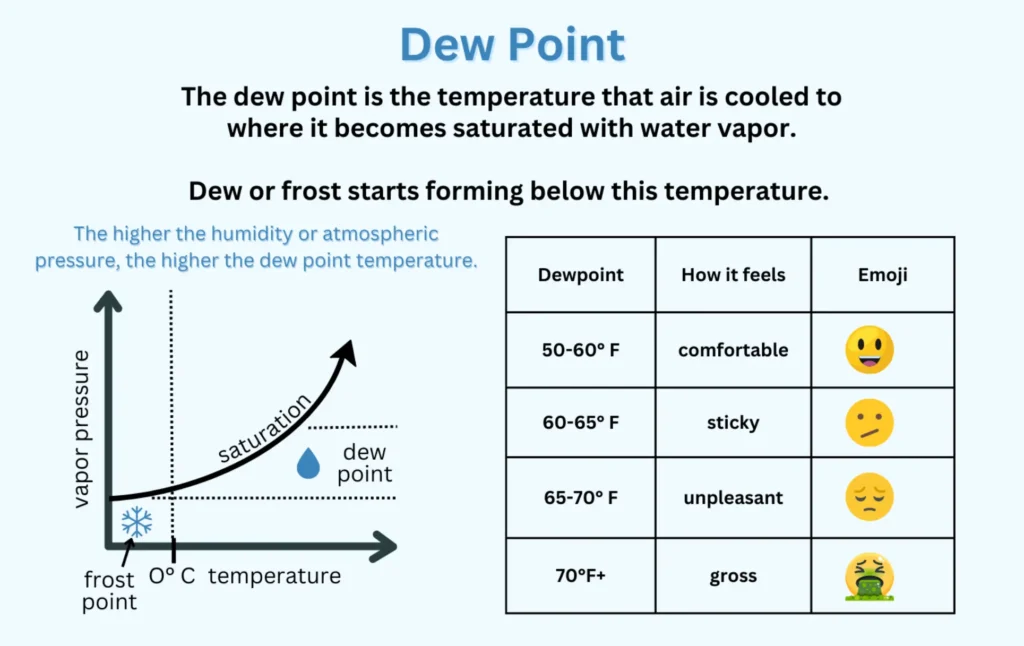Dew point is a crucial concept in meteorology and environmental science, representing the temperature at which air becomes saturated with moisture and water vapor begins to condense into liquid water. This phenomenon has significant implications for weather patterns, agriculture, aviation, and various industrial processes. This article explores what is dew point, how it is calculated, its importance, and its practical applications in everyday life.
Defining Dew Point
Dew point is the temperature at which air must be cooled to reach saturation, meaning the air can no longer hold all the moisture in vapor form. At this temperature, water vapor begins to condense into liquid water, forming dew. It is a direct measure of humidity and provides a more accurate representation of how “sticky” or uncomfortable the air feels compared to relative humidity.
Understanding Humidity
To fully grasp the concept of dew point, it’s important to understand the various ways humidity is expressed:
- Absolute Humidity: This measures the actual amount of water vapor present in a given volume of air, typically expressed in grams per cubic meter (g/m³).
- Relative Humidity: This is a percentage that expresses the current amount of water vapor in the air compared to the maximum amount the air can hold at a given temperature. For example, a relative humidity of 50% means the air contains half of the moisture it can hold at that temperature.
- Dew Point: Unlike relative humidity, which varies with temperature, the dew point is a specific temperature measurement that indicates the moisture content of the air. A higher dew point indicates more moisture in the air, while a lower dew point suggests drier conditions.

If you want some information about hostels and want to know that What is a hostel then checkout our previous blog post.
How Dew Point is Measured
It is typically measured using specialized instruments called hygrometers, which can measure the moisture content in the air. There are several methods for calculating it, but one common approach is to use a wet-bulb thermometer alongside a dry-bulb thermometer.
Wet-Bulb and Dry-Bulb Thermometers
- Dry-Bulb Thermometer: This thermometer measures the air temperature.
- Wet-Bulb Thermometer: This thermometer has a wet cloth around its bulb. As water evaporates from the cloth, it cools the bulb, giving a lower temperature reading. The difference between the dry-bulb and wet-bulb temperatures can be used to calculate the dew point.
Dew Point Calculation
The dew point can also be calculated using a formula that incorporates temperature and relative humidity. The most common formula for calculating it (in degrees Celsius) is as follows:Dew Point=T−(100−RH5)\text{Dew Point} = T – \left( \frac{100 – RH}{5} \right)Dew Point=T−(5100−RH)
Where:
- TTT = Current air temperature (°C)
- RHRHRH = Relative humidity (%)
Importance of Dew Point
Understanding it’s essential for several reasons:
1. Weather Prediction
Dew point plays a critical role in meteorology. It helps meteorologists predict weather conditions such as fog, frost, and thunderstorms. When it is close to the air temperature, it indicates high humidity levels, which can lead to precipitation. A significant drop in temperature with a high dew point can result in fog formation.
2. Comfort Levels
It is a better indicator of comfort than relative humidity alone. For example, a dew point below 10°C (50°F) is generally considered comfortable, while a dew point above 20°C (68°F) can feel oppressive and humid. Understanding it helps people dress appropriately and plan outdoor activities.
3. Agricultural Implications
In agriculture, it affects crop growth and health. High dew points can lead to increased plant transpiration, potentially stressing plants during dry periods. Additionally, dew formation can provide moisture to crops in arid conditions, which is beneficial for growth.
4. Building and HVAC Systems
In the context of construction and HVAC (heating, ventilation, and air conditioning) systems, it is crucial for preventing condensation. High indoor dew points can lead to moisture accumulation, which may promote mold growth and damage building materials. Properly managing it’s levels is essential for maintaining indoor air quality.
5. Aviation Safety
It has a critical factor in aviation safety. High dew points can lead to reduced visibility due to fog formation. Understanding it helps pilots and air traffic controllers make informed decisions regarding takeoff, landing, and overall flight safety.

If you want some information about hostels and want to know that What is a hostel then checkout our previous blog post.
Dew Point in Everyday Life
It affects our daily lives in various ways, from planning outdoor events to managing indoor environments. Here are some practical applications:
1. Outdoor Activities
For outdoor enthusiasts, knowing it can help determine whether conditions are suitable for activities like hiking, camping, or picnicking. A high dew point may make outdoor activities uncomfortable due to heat and humidity.
2. Home Comfort
Understanding it can help homeowners maintain comfort levels indoors. By using dehumidifiers or air conditioning systems, they can manage indoor dew points to prevent discomfort and moisture-related issues.
3. Gardening
Gardeners can benefit from understanding it’s levels, as it can inform them about potential frost conditions and help them decide when to water their plants. Monitoring dew points can also assist in planning irrigation schedules.
4. Health Considerations
High dew points can exacerbate health issues, particularly for individuals with respiratory conditions. Being aware of it’s levels can help sensitive individuals take precautions to manage their health during humid conditions.
Conclusion
Dew point is a fundamental concept that plays a vital role in meteorology, agriculture, HVAC systems, and everyday life. By understanding dew point, individuals can make informed decisions regarding their comfort, safety, and health. Whether predicting weather changes, managing indoor environments, or planning outdoor activities, it serves as an essential metric for assessing moisture in the air.
As climate change continues to influence weather patterns and humidity levels, understanding concepts like it becomes increasingly important. By keeping an eye on it’s readings, we can better navigate our environments and adapt to changing conditions, enhancing our overall quality of life.
If you want some information about hostels and want to know that What is a hostel then checkout our previous blog post.


